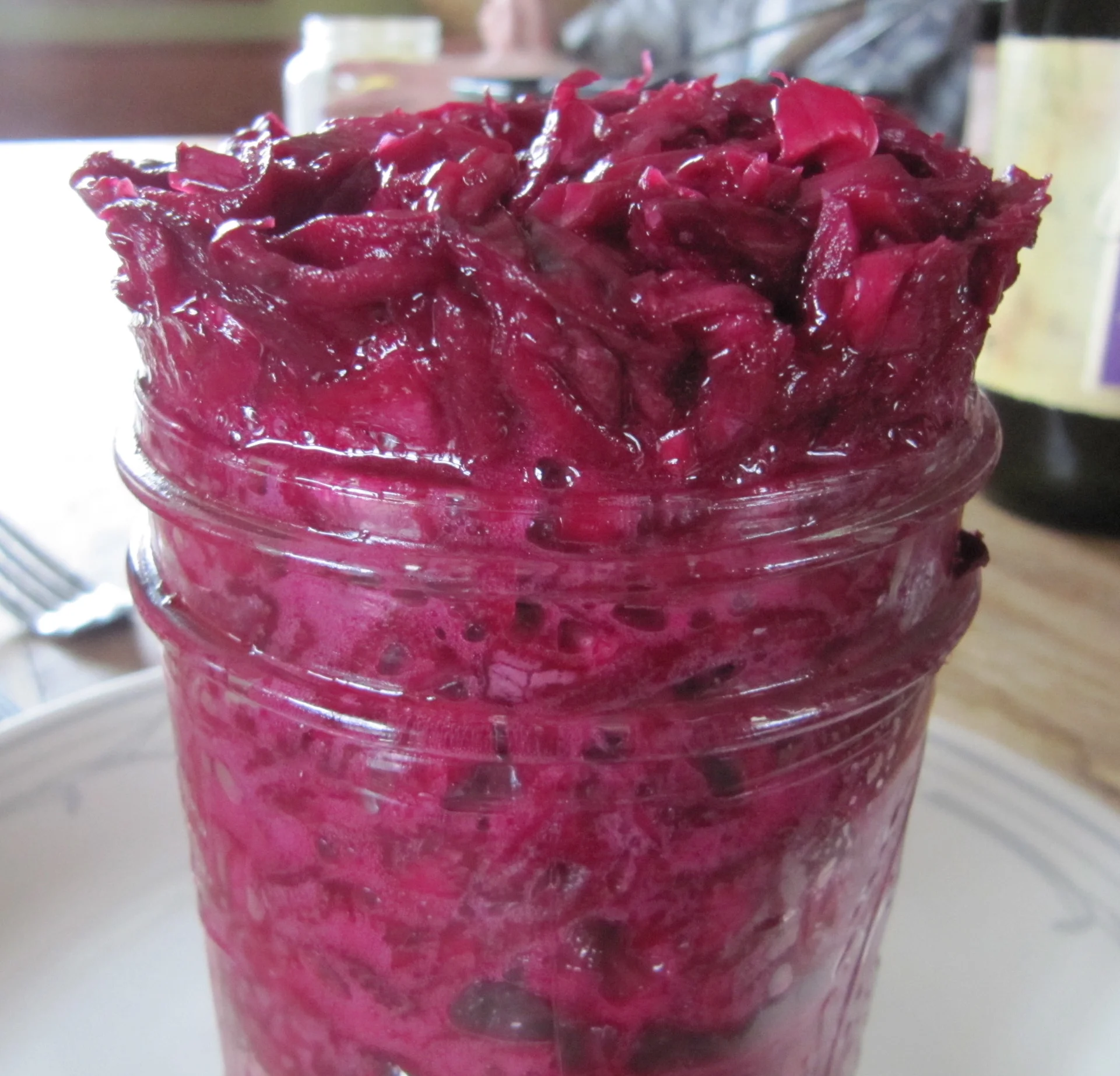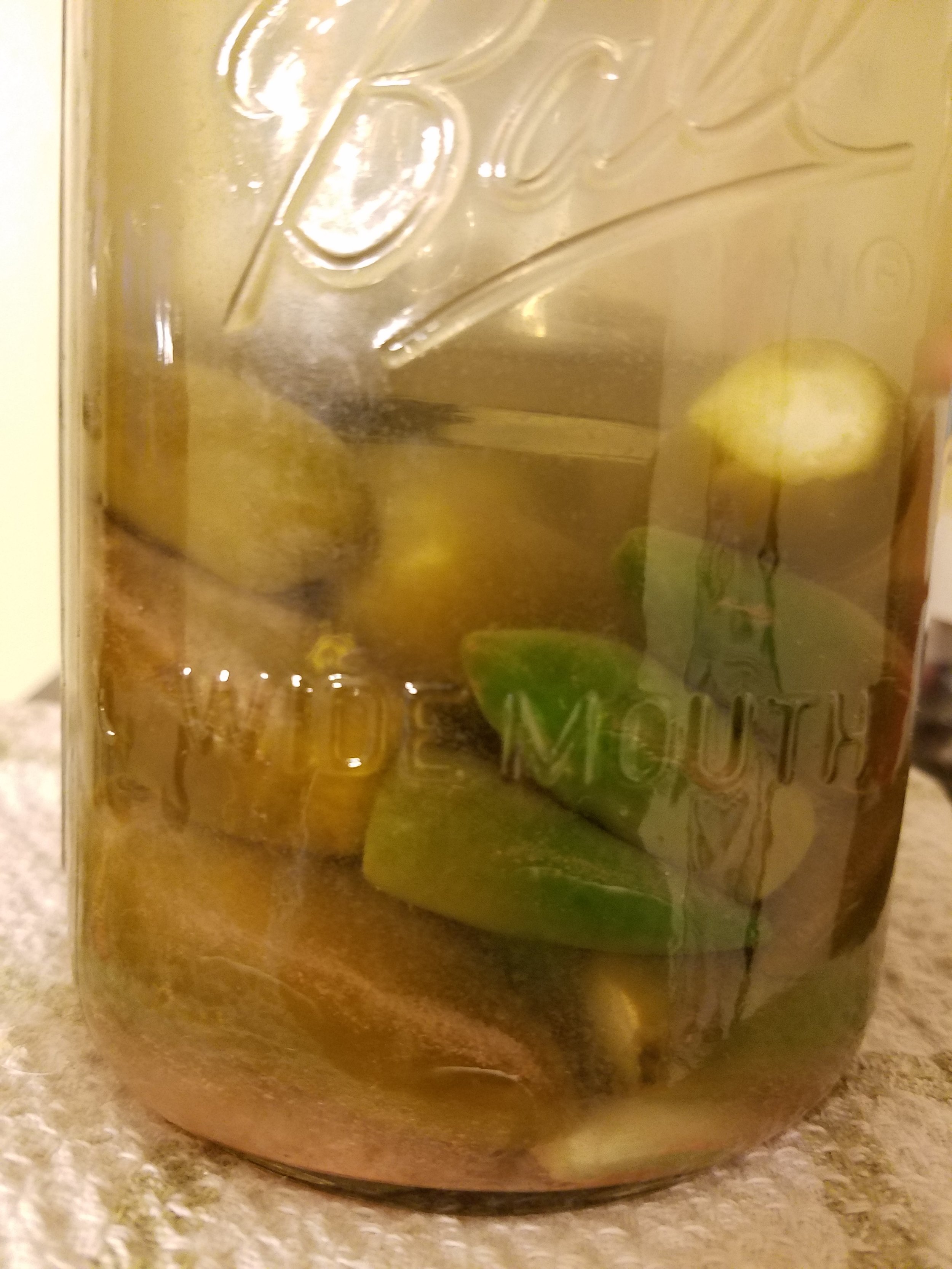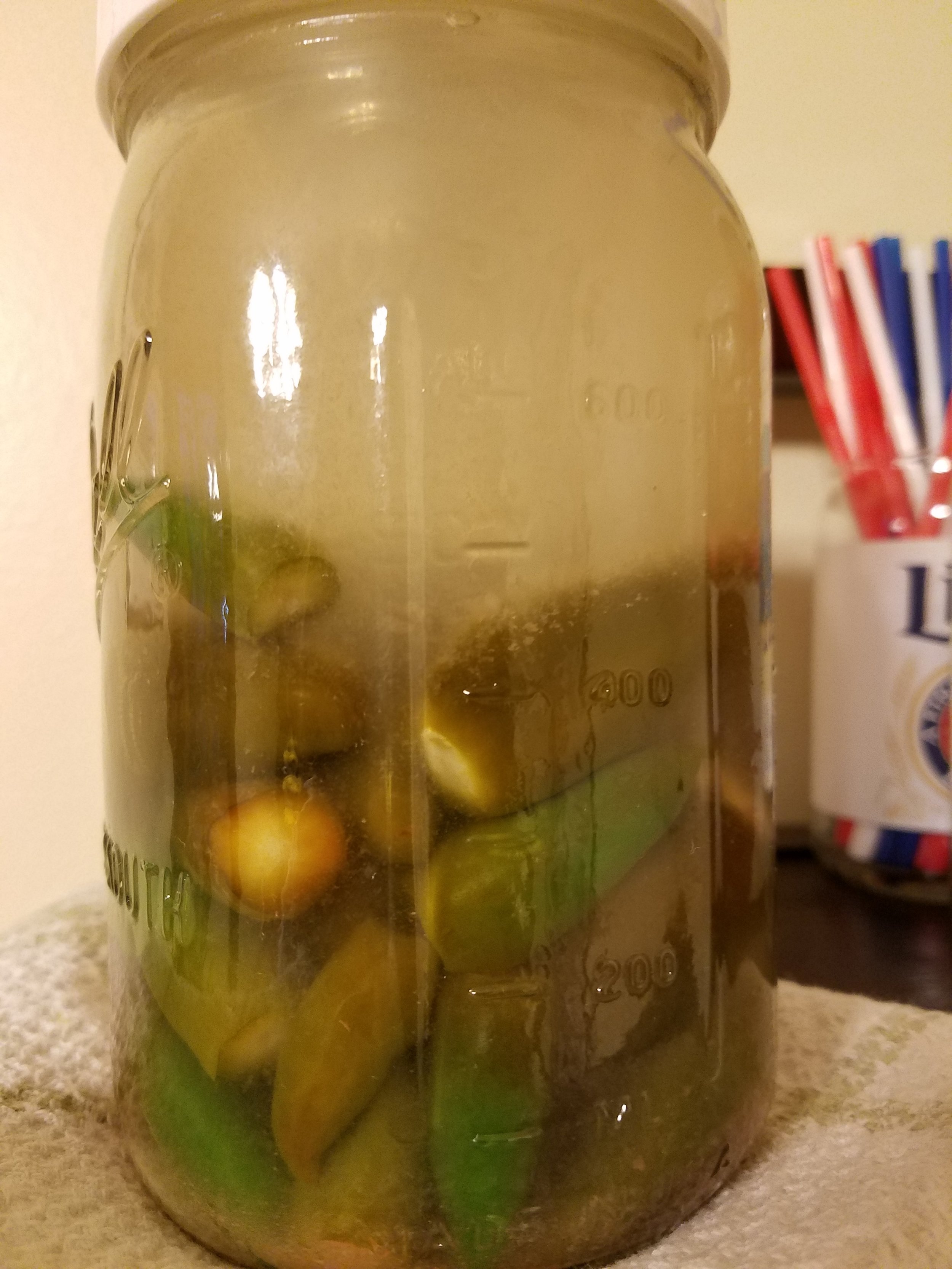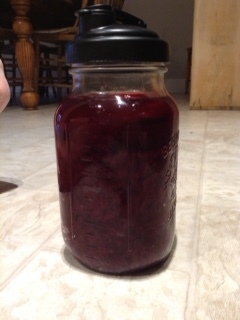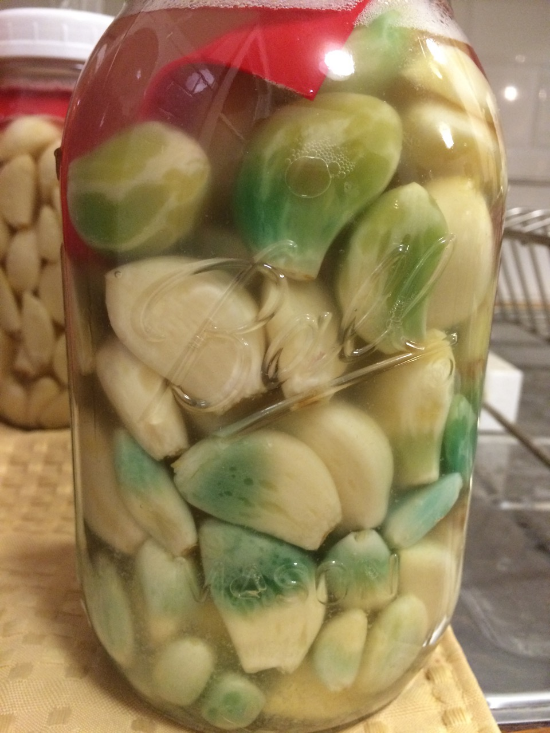Good evening,
I came across your page while worrying about my first ever batch of lacto fermented hot sauce. I've never fermented anything before, so i'd rather be on the safe than sorry side of foodborne illness. When starting, the ferment had tiny bubbles during the first week. The directions I followed stated to massage the peppers after a week, so I opened it up to do so. Other than that, I haven't touched it in 5 weeks. That 1 week mark was also the time, however, that it stopped producing bubbles. Do you mind just letting me know if it looks okay? No bad smell, just a lot of sediment/debris and no bubbles. These are red and green jalapenos along with onions and then spices.
Thank youCasey
**************
Hello Casey,
Thanks for contacting us and sending photos. We have never heard of the massage at the 1 week technique and can’t think of why that would be suggested. Maybe the author had an issue with whole peppers not getting the brine inside them so they thought they should me massaged? Don’t know but I would suggest leaving that off your next batch process, you really should not need nor want to handle the ferments while they are fermenting. Opening the lid also releases the protective CO2 layer that should be captured under the lid and water in your air lock. Is there water in your air lock on top of the lid?
On to good news - they look fine. That sediment you see is normal. I would suggest spooning some out and tasting. If you like then you might think about spooning all the vegetables into your blender and adding ¼ of the brine you think you will use and blend. Check the consistency and keep adding brine until you get to the sauciness you are imagining.
Let us know how it goes Casey.Cheers
Christopher
Different Color in Pickles?
Hi there,
Wondering what’s up with the color difference on my lacto ferment pickles. Same batch, one has a light green band around the outside, and the other is fully dark green all the way to the skin.
Thanks for your help!
Ted
***********************
Hi Ted,
Thanks for reaching out about the cucumbers. I am sorry but we have been traveling for the last 2 weeks and I don’t know if Christopher got back to you. I apologize for the late reply.
The discoloring you see is just the way the fermentation works. The white parts are not fully fermented, called half-sours to some. This is okay as it will continue to ferment in the fridge. How it works is that when you sink the cucumber into salt water the saline of the salt water and the base water in the pickle exchange in an osmosis process because the water is looking to balance itself—meanwhile the lactobacillus are acidifying the whole affair. This is why you see variation in the coloring—different speeds of that exchange.
I hope that helps and you enjoy your pickles.
Cheers,
Kirsten
Pinkish Sediment on Fermenting Peppers and Irregular Color
Hi Kirsten,
I'm new to fermenting, and as my second foray into it, I have a bunch of jars of various whole peppers fermenting, including the pictured jar of jalapenos and serrano peppers. The rest of the jars seem to be doing well, no cloudiness, no mold, etc, but the jalapeno jar's brine is cloudy, and there seems to be a fine, almost powdery looking, pinkish white sediment on the peppers as well as the bottom of the jar. I also skimmed a little mold off the top of the brine at one point - just a few little pinhead-sized floaties. It still smells alright, peppery and pickle-y and salty. Just wondering if this should be composted or if I should continue the ferment? It's been 2.5 weeks since I started it. Oh, and I used Himalayan pink sea salt to create the brine - could this be what the pinkish color is from?
Any advice you could offer would be wonderful! I can also try and take more or different photos if needed as well.
Stefanie M
*********************************
Hi Stefanie,
Welcome to the world of fermentation! Your ferments look fine. The cloudiness and sediment is a normal part of fermentation. In fact, when I see it along with the color change of the veggie I know things are progressing nicely. You did the right think to skim off the mold and that has nothing to do with the sediment you are seeing. You are probably right that the pink color has to do with the salt. We use Redmond Real salt, which also creates pink sediment.
If it smells pickley that is a good sign also. If it was head for the compost it would smell awful.
The thing that I wonder about is that some of the peppers are still quite green. Did you add a few more peppers after a couple of days in? I am guessing if not they are just slower. The ferment looks done except for those peppers. When then turn dull green it likely will be.
Cheers,
Kirsten
*****************************
Hi Kirsten,
Thank you so much for the information! Glad to hear all is normal with the ferment. All of the peppers were added at the same time, but the Serranos are still bright green as opposed to the jalapenos. Should I remove the finished jalapenos for tasting, or should I wait until the serranos are also finished?
Additionally, the other peppers I have fermenting are yellow, red, or other colors (super hot peppers - peach scorpions, chocolate reapers, etc.). Is there a definite color change that will occur with these as well? They are still quite vibrant.
*****************************
You are very welcome.
No need to remove any peppers. The Serranos are just taking their time, and I do see that they are changing. I was just curious as it is a little unusual to see some that are so different in the same jar. And no you won’t see any color change in the reds and yellows, the chocolate reapers are brown right, those might change a bit. It has to do with the colors being water or oil soluble pigments. Carrots, red peppers, etc. are oil soluble and will not change or “fall out” into the brine. Water soluble colors (the pink in a radish) may color the brine and the veggie will turn dull.
Hope that helps.
Fermented Garlic Brine is Blue-Green
Hi Kirsten,
Thank you so much for your kind invitation to send in fermenting issues.
I am an eager newbie to the world of fermenting. Garlic has been my first foray into this world. Please see attached an image of my attempt.
I'm concerned about the colour the brine has turned. It is decidedly green and there is a strong garlic smell emanating from the closed jar. Is this to be expected? I understood the cloves themselves may turn green or blue during the process but not the liquid?
I'd be grateful to know what has happened and what I can do to get a good jar of ferment. Thank you in advance for your assistance.
Kind Regards,
Carol
**************************
Hi Carol,
Ah yes, the blue-green hue. You are right it is a little different seeing it in the brine. My guess is that the brine is thick with the garlic sugars. The whole cloves we make can have a very thick brine and that the blue-green is actually on the garlic that is now in the brine. Sometimes when they sit in the fridge for awhile the blue will work itself through.
This ferment looks okay to me but you be the judge (and trust your gut). If it smells strong like garlic, that is normal, if it smells strong like bad, compost, or whatever, then I would say it is bad. It should also smell a bit pickle-y.
It doesn’t always happen so don’t be discouraged and again I think they are fine, when you are ready to taste them, you will know. Pickle-y acidic garlicky is good, any thing else is not.
Cheers,
Kirsten
Salt and Fermentation
Why? How much? What kind? of salt do I need for fermentation?
Salt seems to cause a lot of consternation for the new fermentista so I thought I would add a salt post to troubleshooting fermentation.
Salt doesn't preserve
First the salt doesn’t preserve the veggies the acidification of the process does so if you are worried about "killing yourself" more salt doesn't make it safer. (Keeping it under the brine does.) What the salt does is give the good bacteria (#lactobacillus) the upper hand to get started and once these guys get going they quickly overwhelm any "bad" bacteria with their acidic output.
Crispy and Tasty
Salt also hardens the pectins (that’s your crisp) and slows down the fermentation a bit, which can be important in hot climates or if you are storing without refrigeration. Salt also makes your ferment taste better, remember salt is a flavor enhancer. Of course too much salt and it is no longer tasty. Choose a mineralized salt you love, taste your ferment for saltiness—should be salty like a chip not briny like a mouthful of seawater. Most importantly — It should be tasty!
What kind of salt?
What kind of salt is personal preference though I don’t use processed industrialized salts, like pickling salt, etc.
How much salt?
This is where things get confusing. The truth is I never measure my own ferments, for me it feel but I do measure and now even weigh the veggies and salt when I am developing a recipe for others. I try to stick to a 1.5 % ratio by vegetable weight. This is enough to do what salt needs to do. Many recipes go as high as 5% and for me that is way too salty and doesn’t make the ferment any safer. So there is a lot of variability!
If you read older recipes you will see things like "packed in salt" or amounts that are crazy high. This is because they had to keep their ferment working a little slower because it stayed in a cool spot like a basement all winter and never was slowed down by a refrigerator. They also did not have as much salt in their regular diet as we do now so it wasn't a problem in many cases the ferment contained the salt that was added to an otherwise bland, starch-based meal.
I have over-salted, does the salt go away?
Somewhere the myth that the salt in a ferment goes away is out there alive and well. Sorry to report it has no where to go--too much salt continues to be too much salt. (In fact if anything a long ferment could evaporate slightly thereby concentrating the salt.)
Thick Sticky Beet Brine
Hello Kirsten.
The brine on my beets is very thick and slimy.
They did not bubble very much for the three days I had them fermenting.
I wonder if I packed them too much?
And if they are safe to eat.
They are crispy and do taste OK but I'm worried. This is my first attempt at fermenting.
My thanks for this help.
Merilyn
__________
Hi Merilyn,
Beet brine is very thick and viscous because beets have so much sugar. The other thing is that 3 days isn’t very long for a ferment like this and sometimes there is a thick slimy phase in fermentation that will work itself out. The picture I am sending is a ferment that is fine but went through this slimy phase. It happens sometimes.
I think you are fine and that they are very safe. The important thing to remember is that if they are bad (as in unsafe) they will be awful smelling and tasting too.
I would let them ferment a little longer and realize beets are also just like that to a point. I hope that helps.
Cheers,
Kirsten
This sauerkraut was fine, it smelled good and had no scum. The problem was the viscous brine. It was quite unappealing. This happened because the ferment had been fermenting very slowly at temperatures in the low 50° F range. We advised the maker of this kraut to move it into a warmer space and ferment it longer and Violá it worked! The kraut was perfect in a few days.
Fermented Garlic Turned Blue
Hi there!
Firstly, I want to say that I love this book! I have been fermenting every vegetable I can get! Force-feeding everyone around me, too. :)
I have a question about garlic. I started the jar a week ago, and it has been bubbling away. For the last day I notice some of the cloves (I put in whole cloves) are turning a strange blue or green color. I'm totally paranoid because of all the press about Chinese garlic! Is turning colors a sign that it's tainted? Is it normal??
Thanks again for writing the amazing book! I'm so happy to have learned something new!
Sarah
***
Hey Sarah,
Anyone force-feeding fermented veggies to the ones they love has our heart. :)
I think every fermentista remembers their first blue garlic. The good news is that our research and experience is that its harmless. If you turn to page 182 in the book you will see the little Fermentista’s Tip on it. The timing of your message is great because Kirsten has a batch of fiery ferments going for the new cookbook and one of them did the blue-green thing on us. We also fermented about 30 lbs of garlic with a farmer friend a week or more ago and all of those are beautiful little creamy orbs like they are supposed to be.
So its okay, it will taste fine and be a conversation starter for sure. Lastly, we have noticed over time in the fridge many times (though not always) this blue fades.
Let us know how all of your creations turn out Sarah and if you have any more questions.
Christopher & Kirsten
White Ring on the Bottom of a Ferment Jar
Hello Kirsten,
I've recently made a bottle of spinach kraut by following one of your recipes. And when it was done, I put it into the fridge. Only after a few days, I saw a "white ring" at the bottom of the bottle. I've attached a picture here to explain better. Do you know why that happened? And is it still safe to eat?
Thanks,
Tracy
Hi Tracy,
The white ring at the bottom of your ferment it fine and a normal part of fermentation. It is similar to the sediment at the bottom of pickles (like Bubbies brand or home fermented pickles). I am happy to report it is very normal and harmless. I believe you are seeing it because the spinach ferment is darker in color than most. If you look carefully at other ferments you will likely see a similar ring.
Cheers,
Kirsten
Here is another troubleshooting question about sediment with the same advice, but maybe that one looks more like yours than this one.
If you would like to learn how to make sauerkraut or pickles we have a couple of courses now available at our fermentation school:
Mastering Fermented Vegetables It covers it all. This complete vegetable fermentation course will teach you the skills and give you the confidence to ferment any vegetable safely and effectively.
Learn to Make Fermented Hot Sauces Learn to ferment hot sauce with any pepper you love. You can choose blazing hot or super mild peppers, fresh or dry and blend in other flavors. This fermentation class will teach you everything you need to make your own safe probiotic hot sauces.
Learn to Ferment Sauerkraut and Pickles In this class we will walk you through making your own delicious lacto-fermented sauerkraut and pickles. This class is a benefit for the displaced folks from the Sept 9, 2020 Fires in Southern Oregon. All proceeds will go to good food aid.
Are my fermented pickles ok?
Dear Kirsten and Christopher,
I bought a copy of your book last month and successfully preserved a bunch of farm fresh vegetables using your fermenting techniques. However, I am having some doubts about my pickling cucumber ferment. I followed the NY Deli-style pickle recipe. After 5 days I noticed Kahm yeast and removed it. Before refrigerating I noticed some slime so I added more salt to the brine. Upon doing so, I noticed white clumps formed the minute I added a bit of grey sea salt. The water itself looks cloudy and some of the pickles seem to want to float. The white clumps have since settled to the bottom of the jar. The brine itself smells great but before tossing the batch and deeming them unsafe to eat I thought I would get a second set of eyes to look at my jars of pickles. Please see the attached pictures. Any feedback would be greatly appreciated.
Many thanks,
Tina
Hello Tina,
Thank you for the pictures, they really help. All veggies want to float in the brine and it looks from the pictures like maybe they did some floating in the jar. If any of them did slip out from the pack and float to the top that would be a conduit for develop enzymatic or yeast infections. We are guessing you may have one or both on this batch. Cloudiness is normal but the white chunk is baffling to us. Our recommendation honestly Tina is to compost this batch and try again. If you are up for that really pack them in tight and under that shoulder of the jar - they should be in there tight enough that none can float to the top. It also helps to find a tannin rich leaf—grape, oak, horseradish to tuck over the top to keep things under the brine and crispy. We hope you still have cukes and that you have a good second batch.
Christopher & Kirsten
Brownish Brine
Question: I just started fermenting. First I made sauerkraut - Delicious! Now I just made your asparagus & caulikraut recipes. The caulikraut looks great but the asparagus brine turned brown after 1 day. Is this okay??? Thanks for your help.
Answer: The brine in this picture looks fine. It is at the beginning of the process and often at this stage the brine will take on some of the colors from the vegetables or spices. This is a normal color for asparagus. You will continue to see changes in the color of the asparagus as well as the brine.
If you would like to learn how to make sauerkraut or pickles we have a couple of courses now available at our fermentation school:
Mastering Fermented Vegetables It covers it all. This complete vegetable fermentation course will teach you the skills and give you the confidence to ferment any vegetable safely and effectively.
Learn to Make Fermented Hot Sauces Learn to ferment hot sauce with any pepper you love. You can choose blazing hot or super mild peppers, fresh or dry and blend in other flavors. This fermentation class will teach you everything you need to make your own safe probiotic hot sauces.
Learn to Ferment Sauerkraut and Pickles In this class we will walk you through making your own delicious lacto-fermented sauerkraut and pickles. This class is a benefit for the displaced folks from the Sept 9, 2020 Fires in Southern Oregon. All proceeds will go to good food aid.

